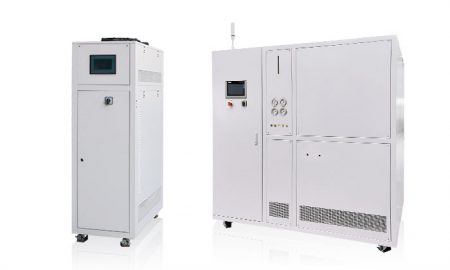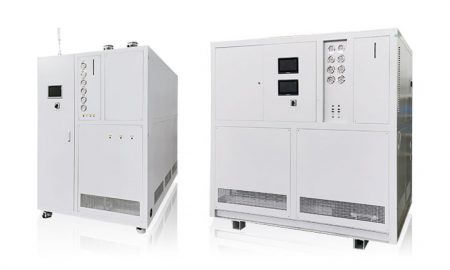Battery Cooling System for Electric Vehicle
The battery cooling system for electric vehicles is a critical component used to maintain battery temperature, improve performance and extend battery life. The battery cooling system removes heat from the battery module or battery stack and dissipates it to the external environment by circulating cooling liquid or heat transfer liquid. The following is a basic introduction to battery cooling system:
Working principle of battery cooling system:
The working principle of the battery cooling system is to remove the heat from the battery through circulating liquid, and then dissipate the heat to the surrounding environment through a radiator or cooling device. Typical work steps are as follows:
1. Liquid coolant flows into the battery: The liquid coolant enters the battery module or battery stack through the pipeline.
2. Absorb heat: When the liquid coolant flows through the battery module, it absorbs the heat generated in the battery.
3. Cooling liquid flows back: The heated liquid refrigerant flows back to the liquid cooling system, taking away the heat.
4. Heat dissipation: The cooling liquid passes through the radiator or cooling equipment and dissipates heat to the external environment. This can be achieved through air cooling or additional circulation in a liquid cooling system.
5. Circulation: The cooling liquid is circulated back to the battery, continuing to absorb heat and keep the temperature of the battery within a safe range.

Advantages of battery cooling system:
Battery cooling systems have some significant advantages in energy storage battery systems, including:
1. Thermal management: The battery cooling system can more accurately manage the temperature of the battery to ensure that it is within the appropriate operating temperature range, improving performance and life.
2. High-power applications: The battery cooling system is suitable for high-power applications and can quickly and effectively cool the battery.
3. Energy saving: battery cooling system can reduce cooling energy consumption and improve energy utilization efficiency.
4. Reduce thermal stress: By cooling the battery evenly, the battery cooling system can reduce thermal stress and extend the life of the battery.
5. Flexibility: The battery cooling system is suitable for various battery configurations and application scenarios, providing more flexibility.
Battery cooling system is an important part of battery technology, helping to improve the performance and reliability of battery systems and reduce operating costs. These systems often require careful design and maintenance to ensure they function properly.\
Correo electrónico: info@lneya.com WeChat ID: +8615251628237 WhatsApp: +86 17851209193

Sistemas de control de temperatura y caudal de calor/frío
Simulación de temperatura para pruebas de calidad de vehículos: prueba de duración de baterías, banco de pruebas de inyectores/motores de combustible, prueba de airbags, banco de pruebas de componentes, etc.
| Temperatura | -25°C ~ +100°C | -40°C ~ +100°C | 0°C ~ +100°C | -40°C ~ +135°C | |||||
| Capacidad de refrigeración | 2,8 ~ 38 kW | 1,2 ~ 60 kW | 1,8 ~ 60 kW | 4 ~ 60kW | |||||
| Nota: Se puede personalizar cualquier rango de temperatura de -150℃ ~ +350℃ y cualquier capacidad de refrigeración. | |||||||||
Temperatura / Presión / Caudal controlables independientemente
1&2: una máquina para el control de dos grupos
| Temperatura | -40 ~ +100℃ 1&2 | 0 ~ +100℃ 1&2 | |||||||
| Capacidad de refrigeración | 1,8 kW*2 ~ 60 kW*2 | 1,8 kW*2 ~ 60 kW*2 | |||||||
| Nota: Se puede personalizar cualquier rango de temperatura de -150℃ ~ +350℃ y cualquier capacidad de refrigeración. | |||||||||
La temperatura permanece constante, la presión y el caudal pueden controlarse independientemente
1&3: una máquina para el control de tres grupos
1&6: una máquina para seis grupos de control
| Temperatura | -40 ~ +100℃ 1&2 | -40 ~ +100℃ 1&3 | -40 ~ +100℃ 1&6 | -20 ~ +100℃ 1&6 | 0 ~ +100℃ 1&2 | 0 ~ +100℃ 1&3 | 0 ~ +100℃ 1&6 | ||
| Capacidad de refrigeración | 2,5 ~ 60 kW | 4 ~ 60kW | 10 ~ 60 kW | 10 ~ 60 kW | 7 ~ 60 kW | 11 ~ 60kW | 18 ~ 60 kW | ||
| Nota: Se puede personalizar cualquier rango de temperatura de -150℃ ~ +350℃ y cualquier capacidad de refrigeración. | |||||||||

Enfriadoras de aceite
Simulación de temperatura para pruebas de calidad de vehículos: prueba de duración de baterías, banco de pruebas de inyectores/motores de combustible, prueba de airbags, banco de pruebas de componentes, etc.
| Temperatura | 0℃ ~ +160℃ | +5℃ ~ +135℃ | |||||||
| Capacidad de refrigeración | 11 ~ 60kW | 15 ~ 38 kW | |||||||
| Nota: Se puede personalizar cualquier rango de temperatura de -150℃ ~ +350℃ y cualquier capacidad de refrigeración. | |||||||||

Sistemas de refrigeración y calefacción para bomba electrónica
| Temperatura | -40°C ~ +135°C | ||||||||
| Capacidad de refrigeración | hasta 60 kW | ||||||||
| Nota: Se puede personalizar cualquier rango de temperatura de -150℃ ~ +350℃ y cualquier capacidad de refrigeración. | |||||||||

Cámara de prueba de baterías a alta y baja temperatura
| Temperatura | -40℃ ~ +100℃ | -40℃ ~ +100℃ | |||||||
| Capacidad de refrigeración | 1,8 ~ 7,5 kW | 4 ~ 15 kW | |||||||
| Nota: Se puede personalizar cualquier rango de temperatura de -150℃ ~ +350℃ y cualquier capacidad de refrigeración. | |||||||||

Sistemas de refrigeración o calefacción directa para automóviles
| Tipos | Refrigeración directa | Direct Cooling & Heating | |||||||
| Capacidad de refrigeración | 5 ~ 10kW | 5 ~ 10kW | |||||||
| Nota: Se puede personalizar cualquier rango de temperatura de -150℃ ~ +350℃ y cualquier capacidad de refrigeración. | |||||||||
 LNEYA
LNEYA
 简体中文
简体中文


















































































